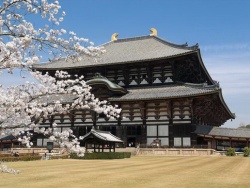Difference between revisions of "Administration hall"
(Created page with "thumb|250px| administration hall (kudō 庫堂, kusu 庫司, kuin 庫院) Literally "granary," "storehouse," or "treasury...") |
|||
| Line 2: | Line 2: | ||
[[administration hall]] ([[kudō]] [[庫堂]], [[kusu]] [[庫司]], [[kuin]] [[庫院]]) | [[administration hall]] ([[kudō]] [[庫堂]], [[kusu]] [[庫司]], [[kuin]] [[庫院]]) | ||
| − | Literally "granary," "storehouse," or "treasury" ([[ku]] [[庫]]) "hall" ([[dō]] [[堂]]), "office" ([[su]] [[司]]), or "compound" ([[in]] [[院]]). In {{Wiki|Chinese}} [[Buddhist]] [[monasteries]] and the {{Wiki|medieval}} [[Japanese Zen]] [[monasteries]] modeled after them, the administration hall was a large building that included the main kitchen facilities, stores of [[food]] and other supplies, and the offices of many [[monk]] administrators, including that of prior ([[tsūsu]] [[都寺]]), comptroller ([[kansu]] [[監寺]]), assistant comptroller ([[fūsu]] [[副寺]]), head cook ([[tenzo]] [[典座]]), and labor steward ([[shissui]] [[直歳]]). The administration hall was located on the [[east]] side of the [[monastery]], opposite the [[sangha]] hall ([[sōdō]] [[僧堂]]), which stood on the [[west]] side. Those two buildings were the [[vital]] centers of the management wing and the practice wing of the [[monastery]], respectively. In {{Wiki|present}} day [[Japanese Zen]], only the two [[Soto School]] head [[monasteries]], [[Eiheiji]] and [[Sōjiji]], have administration halls proper. All other [[monasteries]] and [[temples]] have a kitchen-residence ([[kuri]] [[庫裡]]) instead, which evolved from the layout of the {{Wiki|medieval}} [[abbot's]] quarters. "kitchen-residence," "[[abbot's]] | + | Literally "granary," "storehouse," or "treasury" ([[ku]] [[庫]]) "hall" ([[dō]] [[堂]]), "office" ([[su]] [[司]]), or "compound" ([[in]] [[院]]). In {{Wiki|Chinese}} [[Buddhist]] [[monasteries]] and the {{Wiki|medieval}} [[Japanese Zen]] [[monasteries]] modeled after them, the administration hall was a large building that included the main kitchen facilities, stores of [[food]] and other supplies, and the offices of many [[monk]] administrators, including that of prior ([[tsūsu]] [[都寺]]), comptroller ([[kansu]] [[監寺]]), assistant comptroller ([[fūsu]] [[副寺]]), head cook ([[tenzo]] [[典座]]), and labor steward ([[shissui]] [[直歳]]). The administration hall was located on the [[east]] side of the [[monastery]], opposite the [[sangha]] hall ([[sōdō]] [[僧堂]]), which stood on the [[west]] side. Those two buildings were the [[vital]] centers of the management wing and the practice wing of the [[monastery]], respectively. In {{Wiki|present}} day [[Japanese Zen]], only the two [[Soto School]] head [[monasteries]], [[Eiheiji]] and [[Sōjiji]], have administration halls proper. All other [[monasteries]] and [[temples]] have a kitchen-residence ([[kuri]] [[庫裡]]) instead, which evolved from the layout of the {{Wiki|medieval}} [[abbot's]] quarters. "kitchen-residence," "[[abbot's quarters]]." |
{{R}} | {{R}} | ||
[http://global.sotozen-net.or.jp/eng/library/glossary/individual.html?key=administration_hall global.sotozen-net.or.jp] | [http://global.sotozen-net.or.jp/eng/library/glossary/individual.html?key=administration_hall global.sotozen-net.or.jp] | ||
[[Category:Buddhist Monasteries]] | [[Category:Buddhist Monasteries]] | ||
[[Category:Zen]] | [[Category:Zen]] | ||
Latest revision as of 13:22, 3 March 2014
administration hall (kudō 庫堂, kusu 庫司, kuin 庫院)
Literally "granary," "storehouse," or "treasury" (ku 庫) "hall" (dō 堂), "office" (su 司), or "compound" (in 院). In Chinese Buddhist monasteries and the medieval Japanese Zen monasteries modeled after them, the administration hall was a large building that included the main kitchen facilities, stores of food and other supplies, and the offices of many monk administrators, including that of prior (tsūsu 都寺), comptroller (kansu 監寺), assistant comptroller (fūsu 副寺), head cook (tenzo 典座), and labor steward (shissui 直歳). The administration hall was located on the east side of the monastery, opposite the sangha hall (sōdō 僧堂), which stood on the west side. Those two buildings were the vital centers of the management wing and the practice wing of the monastery, respectively. In present day Japanese Zen, only the two Soto School head monasteries, Eiheiji and Sōjiji, have administration halls proper. All other monasteries and temples have a kitchen-residence (kuri 庫裡) instead, which evolved from the layout of the medieval abbot's quarters. "kitchen-residence," "abbot's quarters."
